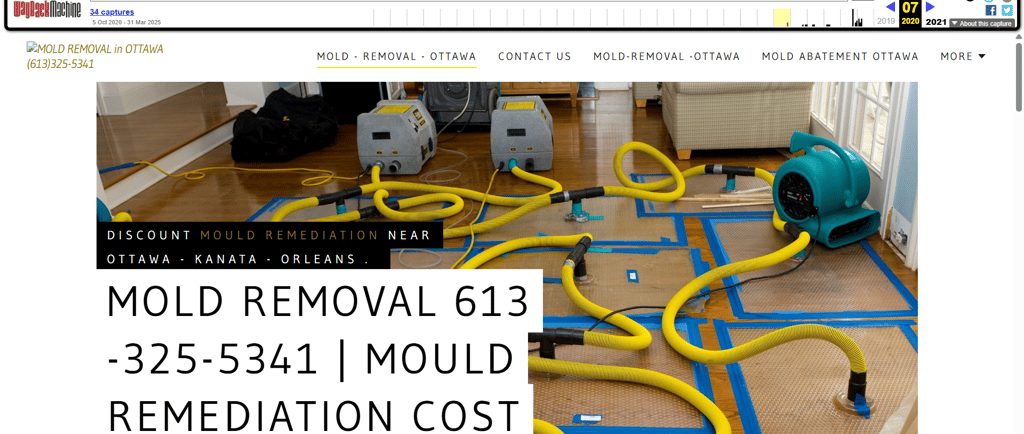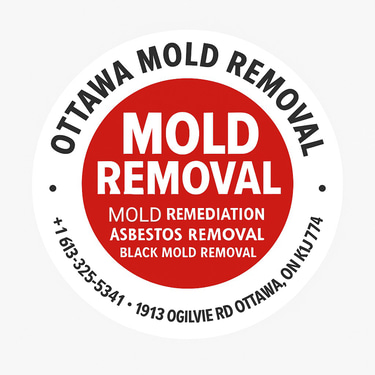

Mould Remediation in Ottawa Ontario
What is Mould?
Mould is a type of fungus that thrives in moist, humid environments. It spreads by producing tiny spores that can grow on various surfaces, especially in damp areas like bathrooms.
Common types of mold include black mould (Stachybotrys), green mold (Penicillium), and white mold. Prolonged mold exposure can lead to health issues such as respiratory problems and allergies. Preventing mold requires controlling moisture levels and ensuring proper ventilation.
Here are some critical statistics about mould you might not know.
Mould Statistics
Mould Types: Over 100,000 mold species exist, with some posing significant health risks.
Fungi Species: The CDC estimates that 500 different species of fungi are currently thought to be harmful to people.
Health Impact: Approximately 20% of individuals are sensitive to mold, leading to respiratory and allergic reactions.
Home Invasion: Up to 50% of households have hidden mold issues, often unnoticed until health symptoms or structural damage appears.
Moisture Connection: Mold growth can start within 24-48 hours in damp conditions, emphasizing the need for swift moisture control. – Fisk and Berkeley Laboratory colleagues found that dampness and mold exposures increase the occurrence of a range of respiratory problems by 30–50%. (Source: Ncbi.nlm.nih.gov )
According to a report published in the World Health Organization’s (WHO) journal The Lancet, 92% of the world’s population lives in places where air quality levels exceed WHO limits. (Source)
It is estimated that approximately 800,000 or 7 percent of the citizenry have been exposed to some extent and become sensitized to compounds present in poorly ventilated indoor air. (Source: Ncbi.nlm.nih.gov)
Mold can be found in up to 9% of homes with a terrace, 26% of medical facilities like outpatient clinics and hospitals, and 18% of elementary to high school facilities. (Source: Ncbi.nlm.nih.gov )
Each year, nearly 600,000 children under 5 years old die from the effects of air pollution.(Source: Berkley.edu)
According to a recent survey, 40% of homes in Ottawa Ontario Canada. are affected by mold.
20% of the population carries genes that make them more susceptible to mold-related health conditions, according to a study published in the journal Genome Biology.
Researchers have found around 270 Species of Mold in Canada. (Source: pbs.org )
About 70% of Homes Have Mold.
Indoor mold and dampness are associated with an estimated $3.7 billion in annual health care costs for allergic rhinitis.
In Canada, Ottawa, Ontario Tops the List of Most Allergy Patients with Mold and Mildew Sensitivities at 21%
Any kind of water damage (flood, pipe burst, leakage) can facilitate the growth of a mold in as soon as 24-48 hours. (Source: realtimelab.com/mold-statistics)
Sources – FEMA mold resource – NIEHS on mold – Mold allergy
Common Types Of Mold
Mold spores [Ref: Wikipedia.org, Commons.Wikimedia] travel indoors on clothing, shopping bags, and even on pets. They also weave their way into a house through windows and leaky roofs. Once the invisible spores settle on a wet surface, they can begin to reproduce within 24 to 48 hours. Researchers have identified over 100,000 different strains of mold, but they all fall into one or more of three categories.
Allergenic: This means that they can trigger allergic reactions and asthma attacks in people with allergies and cause mild allergic symptoms in those without allergies.
Pathogens: These mold usually only cause symptoms in people with immune system disorders or in those who have or have suffered from a serious illness.
Toxigenic: These types of molds are the most dangerous and can cause serious health problems, even in healthy people.
Lets know more about some common types of mold or fungi seen in household properties in Toronto, GTA areas.
Aspergillus
A common mold found on foods and in home air conditioning systems, can grow on any wet surface. With over 180 strains, many of different colors, it can be challenging to identify. While most strains are harmless, a few can cause serious illness or lead to aspergillosis in individuals with weakened immune systems. Since testing is the only way to determine if the mold in your home is Aspergillus, it’s best to promptly clean up all types of mold upon discovery.
Cladosporium
is typically a black or green “pepper like” substance that grows on the back of toilets, painted surfaces and fiberglass air ducts.
Fusarium:
Temperature: thrives and spreads even in temperatures near zero
Appearance: pinkish or reddish spots
Grows on: soft textiles like carpet, upholstery, clothes, wallpaper, draperies
Risk reduction: frequent cleaning with a vacuum equipped with a HEPA filter
Penicillium:
Allergenic and pathogenic: yes
Symptoms: sinusitis, difficulty breathing, asthma episodes, chronic health problems in people with immune system disorders
Appearance: bluish-green fluffy mold
Habitat: homes with flooding or water damage, constant humidity required
Treatment: professional mold treatment recommended
Trichoderma:
Appearance: Small raised white spots, green mold in damp areas
Habitat: damp places like near leaky windows or around showers
Growth: quick in damp places
Symptoms: coughing, sneezing, bronchial infections
Mold [Ref: cdc.gov] that appears to be orange or red in color is typically found outdoors, given its nature to thrive on decaying plants or moist wood. This type of mold, can appear slimy, is harmless and should only be removed for aesthetic purposes.
There are many types of mold that look black, and not all “black mold” are as toxic as Stachybotrys.
Commonly referred to as “black mold” for its greenish-black color, Stachybotrys is a toxic mold that thrives in humid conditions and is most commonly found on cellulose-like materials, such as wood, drywall or even piles of leaves. wet. It starts with small black spots that get bigger and spread..
It is crucial to prevent the growth of mold at early stages to avoid any health issues and inconvenience and a mold remediation professional can easily do this. Lets talk about indoor mold growth in buildings and homes and other important aspects of mold removal.
Mould Remediation & Mold Removal In Ottawa, ON
Mold growth in homes is a serious concern that many Ottawa residents may overlook until it becomes a health issue. Mold is not only unsightly but can also have significant effects on the respiratory system. Understanding the connection between mold and respiratory health is crucial for homeowners in Ottawa, where humidity levels and aging homes create ideal conditions for mold growth. In this article, we will explore how mold affects respiratory health and what steps Ottawa homeowners can take to prevent and address mold growth through mold removal in Ottawa.
What is Mold and How Does it Grow in Homes?
Mold is a type of fungus that thrives in damp, humid environments. It reproduces through spores that spread through the air and can settle on surfaces, where they grow when exposed to moisture. Common indoor molds include species such as Aspergillus, Cladosporium, and Stachybotrys (black mold).
Mold requires moisture to grow, which is why it is frequently found in areas of the home where water damage or high humidity is present, such as basements, bathrooms, and attics. In Ottawa, the seasonal fluctuations in temperature and humidity contribute to mold growth, particularly in older homes that may have structural issues like leaks or poor insulation. It’s important for homeowners to recognize the conditions that promote mold and take steps to mitigate the risks.
The Respiratory Health Risks of Mold Exposure
Mold exposure is linked to several respiratory health problems. The most common issues include allergic reactions, asthma, chronic coughing, and sinus congestion. Mold spores, when inhaled, can trigger these conditions, especially in sensitive individuals. People with asthma or respiratory diseases are at a higher risk of experiencing exacerbated symptoms, which can lead to more severe health issues over time.
For Ottawa residents, the humid summers and cold winters can create the perfect breeding ground for mold, especially in homes that have had water damage due to flooding or condensation. Even if the mold is not visibly present, its spores can still be in the air, causing respiratory distress in those who are exposed to it regularly.
Mold Growth in Ottawa Homes: Specific Concerns
Ottawa’s climate presents unique challenges for homeowners trying to avoid mold growth. During the humid summer months, moisture can accumulate in the home, and without proper ventilation, mold can start to grow. In winter, the cold air outside can lead to condensation on walls and windows, creating the perfect environment for mold to thrive.
Older homes in Ottawa are particularly susceptible to mold growth due to outdated insulation, poor ventilation, and the likelihood of hidden leaks in the plumbing. Homeowners who experience basement flooding, roof leaks, or faulty windows should be especially diligent about monitoring for mold growth and taking preventive measures.
Identifying Mold-Related Health Symptoms
If you suspect that mold might be affecting your home, it’s essential to watch for signs of respiratory issues, especially in family members who may be particularly sensitive. Common symptoms of mold exposure include:
Persistent coughing or wheezing
Nasal congestion or a runny nose
Sneezing, especially in the morning
Irritation of the throat, eyes, or skin
Fatigue and general malaise
Press enter or click to view image in full size
For Ottawa homeowners, recognizing these symptoms early can prevent further complications. If anyone in your household is experiencing these issues and you suspect mold may be the culprit, seeking mold removal in Ottawa should be a priority. Early intervention can help mitigate health risks and protect the home’s occupants from ongoing exposure.
Mold Prevention and Remediation in Ottawa Homes
Preventing mold growth in Ottawa homes is possible with proper maintenance and attention to moisture control. Key steps to prevent mold include:
Control Humidity Levels: Keep indoor humidity levels below 60%. This can be achieved using dehumidifiers, especially in areas like basements or bathrooms.
Improve Ventilation: Proper ventilation is essential in areas prone to moisture, such as bathrooms and kitchens. Ensure that vents lead outdoors, not into attics or crawl spaces.
Fix Leaks Quickly: Water leaks are the most common way mold enters a home. Whether it’s a leaking pipe, a roof leak, or condensation around windows, repairing leaks as soon as they occur can help prevent mold from taking hold
Routine Inspections: Regularly check areas where mold is more likely to grow, such as the basement, attic, and behind appliances. If you spot early signs of mold growth, act immediately by calling in a professional for mold removal in Ottawa.
If mold has already taken hold in your home, it’s important to enlist the help of professional mold remediation services. Mold removal in Ottawa involves specialized equipment and techniques to ensure that the mold is fully removed, and the underlying moisture problems are addressed. Trying to remove mold yourself can sometimes make the issue worse, as mold spores can spread if not properly contained.
Protect Your Health: The Importance of Mold Removal in Ottawa Homes
If you suspect mold is affecting your home, taking action is crucial not only for the well-being of your property but also for the health of your family. Mold removal in Ottawa is essential for eliminating mold-related health risks and improving indoor air quality. Professional remediation services can safely remove the mold, identify the source of moisture, and provide recommendations for keeping your home mold-free.
Take Action Today
Don’t wait until mold affects your health. If you suspect mold in your home, contact a professional mold removal company in Ottawa right away. By addressing mold issues early, you can prevent respiratory health problems and ensure that your home remains a safe, healthy place for you and your family.
Press enter or click to view image in full size
If you live in Ottawa and are concerned about mold in your home, make sure to schedule an inspection with a trusted mold removal in Ottawa expert. Protect your home and your health by taking the necessary steps today.
ottawa mould
Contact
Support
mould
© 2024. All rights reserved.
